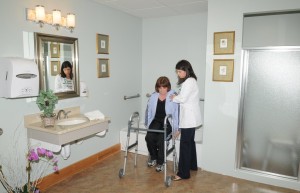
Do you need a break from caregiving?
June 2, 2023
5th Annual Breast Cancer Event — Thurs. Oct. 12th
July 3, 2023Empower Stroke Patients with Physical Therapy at Candlewood Valley
 Stroke is a leading cause of long-term disability worldwide. Stroke survivors often experience physical and cognitive impairments that limit their ability to perform daily activities, impacting their quality of life. Physical therapy is essential to stroke rehabilitation, helping patients regain mobility and independence. This article explores the role of physical therapy in stroke recovery and the different techniques used by physical therapists.
Stroke is a leading cause of long-term disability worldwide. Stroke survivors often experience physical and cognitive impairments that limit their ability to perform daily activities, impacting their quality of life. Physical therapy is essential to stroke rehabilitation, helping patients regain mobility and independence. This article explores the role of physical therapy in stroke recovery and the different techniques used by physical therapists.
Understanding Stroke and Its Implications
A stroke occurs when blood flow to the brain is interrupted, leading to brain damage. The severity and location of the damage determine the type of stroke and the extent of the resulting impairments. Common impairments include muscle weakness, spasticity, balance and coordination problems, and difficulty with activities of daily living (ADLs) such as dressing, grooming, and eating.
Physical Therapy Techniques for Stroke Rehabilitation
Physical therapy aims to improve a patient’s physical function, reduce impairments, and enhance their quality of life. A physical therapist conducts an initial assessment to determine the patient’s impairments and develops a personalized treatment plan. The following are some of the techniques used in stroke rehabilitation:
- Range of Motion Exercises
Patients may experience muscle stiffness or spasticity, limiting their range of motion. A physical therapist will use exercises to stretch and strengthen muscles, increasing flexibility and reducing spasticity.
- Gait Training
Walking is a fundamental ADL that stroke survivors often struggle with. A physical therapist works with the patient to improve their walking ability, using exercises such as weight shifting, balance training, and treadmill training.
- Balance Training
Stroke survivors often experience balance problems, making it difficult to stand or walk without assistance. A physical therapist will use balance exercises to improve postural control, reducing the risk of falls.
- Functional Training
This technique involves practicing ADLs such as dressing, grooming, and eating. A physical therapist will work with the patient to identify areas of difficulty and develop strategies to improve their ability to perform these tasks.
- Electrical Stimulation
This technique uses electrical impulses to stimulate muscles, reducing spasticity and improving muscle strength.
The Benefits of Physical Therapy for Stroke Recovery
Physical therapy is a critical component of stroke rehabilitation, offering numerous benefits to patients. Some of the benefits include:
- Improved Mobility
Physical therapy helps patients regain mobility, allowing them to perform ADLs independently.
- Reduced Pain
Range of motion exercises and electrical stimulation can reduce pain and muscle stiffness.
- Improved Quality of Life
Physical therapy helps patients regain independence, enhancing their quality of life.
- Reduced Risk of Falls
Balance and gait training reduce the risk of falls, preventing further injury.
- Improved Mental Health
Physical therapy can improve a patient’s mental health by reducing depression, anxiety, and stress.
Final Thoughts
Physical therapy is an essential component of stroke rehabilitation, offering numerous benefits to patients. A physical therapist will work with the patient to identify their impairments and develop a personalized treatment plan. Techniques such as range of motion exercises, gait training, balance training, functional training, and electrical stimulation can improve mobility, reduce pain, enhance the quality of life, reduce the risk of falls, and improve mental health. Stroke survivors should seek physical therapy as a part of their rehabilitation process to regain their independence and improve their overall quality of life.
If you’re looking for high-quality cardiac rehabilitation programs, look no further than Candlewood Valley. Our team of expert healthcare professionals is dedicated to helping you regain your strength and improve your overall health. Contact us today at 860-222-7651 to learn more about our services and how we can help you achieve your goals.

